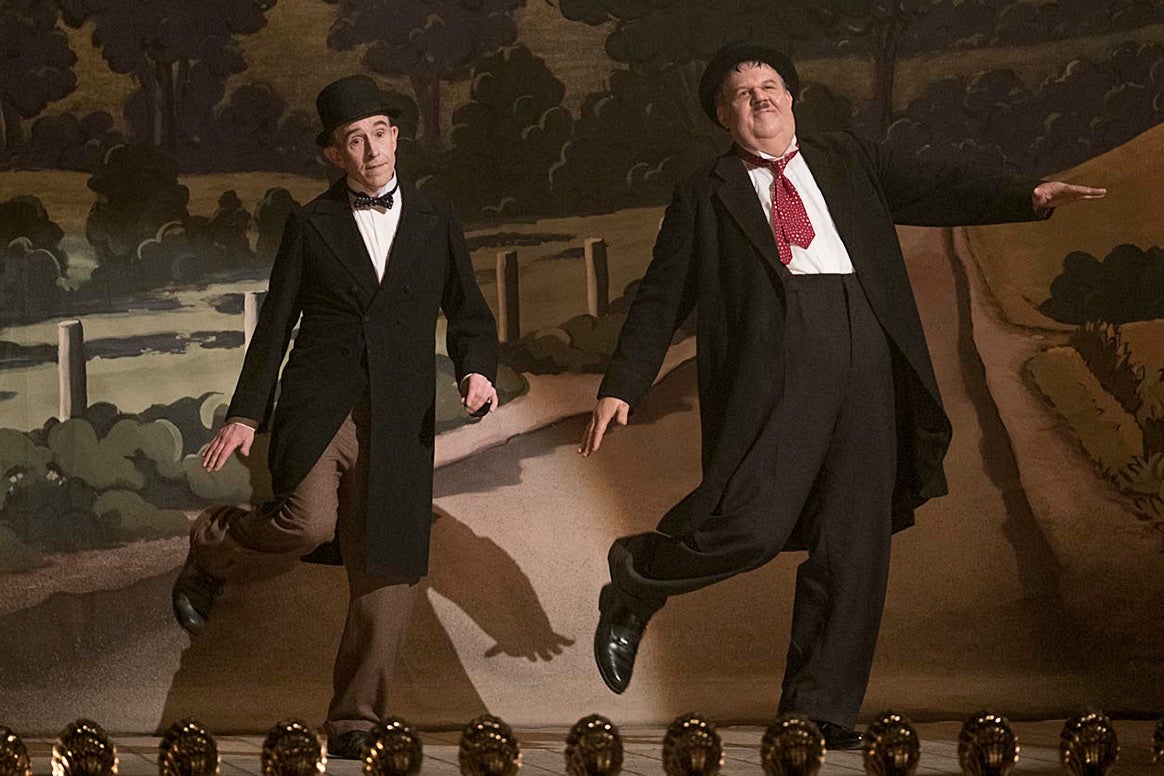Stan & Ollie, the new film from director Jon S. Baird about the greatest double act in comedy history, is sort of a double act itself. Half of it is a sensitive character study of two artists on the downslope, an actor’s showcase anchored by brilliant performances from Steve Coogan (Stan Laurel) and John C. Reilly (Oliver Hardy), with supporting players Shirley Henderson (Lucille Hardy) and Nina Arianda (Ida Laurel) doing exceptional work that is all the more exceptional considering how colorless the supporting players often are in two-handers like this. The other half is a by-the-numbers biopic that dutifully shuffles from struggle to success to catastrophe to redemption-slash-artistic-immortality. Fortunately for audiences, the character study is the fat one.
The film is an account of Laurel and Hardy’s 1953 music-hall tour of the U.K., long after the height of their fame as a screen comedy duo. Barring a few flashbacks—and an obligatory-but-still-fun long tracking shot through a bustling studio—Jeff Pope’s screenplay stays in this diminished world of fleabag hotels and near-empty theaters, a structural decision that lets Coogan and Reilly dive deeper into their characters’ relationship than a cradle-to-grave approach would have. Instead of the usual parade of paper-thin cameos from everyone the subject of a biopic ever worked with or married (four wives for Laurel, three for Hardy), we get fully fleshed out portraits at a particular moment in time, which the actors take full advantage of. Henderson and Arianda particularly benefit from getting to create vivid versions of Hardy’s and Laurel’s final wives.
The screenplay cobbles together its fall-and-rise story from three different Laurel and Hardy tours of the U.K. As “based on a true story” movies go, it’s not a particularly egregious reshaping, though it’s a little disappointing to see a film whose tight focus seems tailor-made to free it from the constraints of the genre color so vehemently inside the lines. Inside those lines, though, the colors are remarkable.
Coogan’s Stan Laurel is a wonderful creation, a ball of frustrated ambition who blames Hardy for missing their chance to strike out on their own at their career’s peak. Coogan walks a tightrope between Laurel’s infectious love of the creative process—some of the happiest scenes in the film are just Laurel trying to work out gags for a doomed Robin Hood film the pair hoped to make—and the person he fears he’ll become if he can’t: an old man haunting the waiting rooms of unsympathetic producers, a phone call no one wants to take. And Reilly’s Oliver Hardy—achieved with the help of a fat suit and three hours of prosthetics—is much more than a simulacrum. Actors shouldn’t get extra credit for eking out a performance under tons of foam latex, but John C. Reilly does the bulk of the work here, painting a portrait of a man who is capable of being content in a way that is wholly inaccessible to Laurel. (The real Oliver Hardy once said he didn’t want to write or direct films like his partner did because “just doing the gags was hard enough work.”) As the men’s wives, Henderson and Arianda build their own double act—becoming the comic relief in a film about Laurel and Hardy is quite a trick.
And then there are Stan & Ollie, the characters Stan Laurel and Oliver Hardy played on film and stage for decades. In a sense, Coogan and Reilly have it easier here: They step into their characters’ characters at the end of their real-life careers, so a gap between their slapstick and the preternatural physical comedy of the original Laurel & Hardy can be explained away by age and sorrow. But there really isn’t that big a gap: Their version of the dance from Way Out West is delightful in the same way and for the same reasons. And a sequence imagining Laurel and Hardy in their never-filmed Robin Hood movie—an interlude for which cinematographer Laurie Rose’s palette briefly blows out into a passable imitation of three-strip Technicolor—is probably the closest thing anyone will ever get to a glimpse of a new Laurel & Hardy film.
In the end, though, Stan & Ollie is less of a tribute to Laurel and Hardy’s work and more a portrait of a creative partnership coming to an end. Artistic collaborations are often compared to marriages, and the metaphor works in cases where the artists split over creative differences: blowup fights, infidelities, mismatched levels of talent or ambition, and so on. But there’s one way in which collaborations are nothing like marriages: Other people get a say in the outcome. That’s the sadness barely audible under the bang and clatter of Stan & Ollie’s whirring biopic motor: For years, Laurel & Hardy had something everybody wanted. Then, abruptly, everybody didn’t. Another nice mess.
Correction, Dec. 28, 2018: This post originally misidentified who played Lucille Hardy and who played Ida Laurel.
